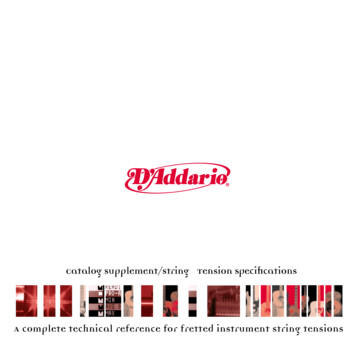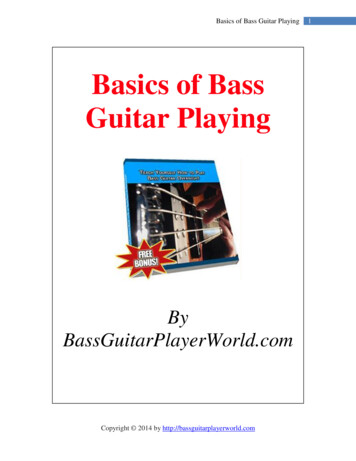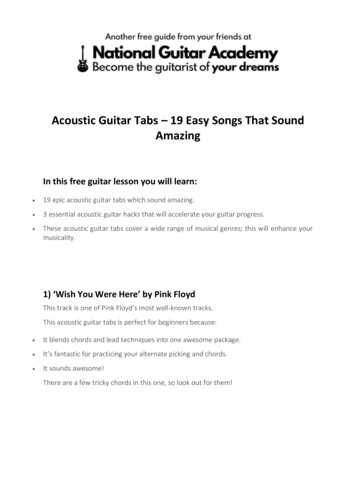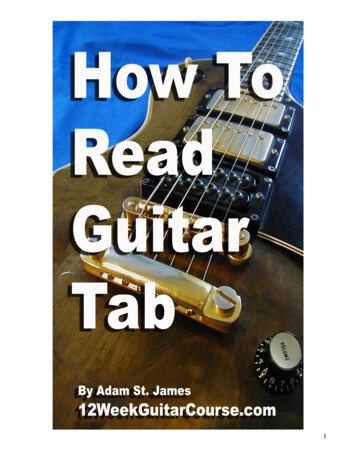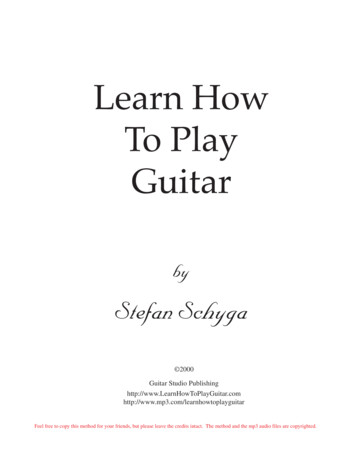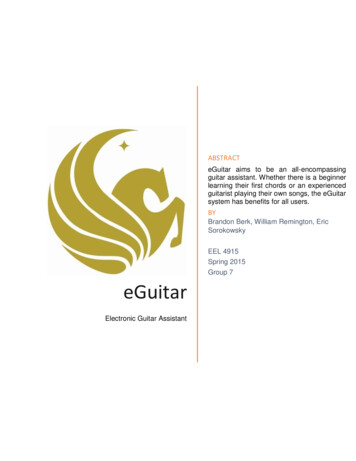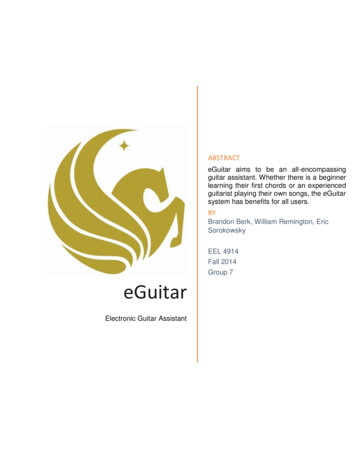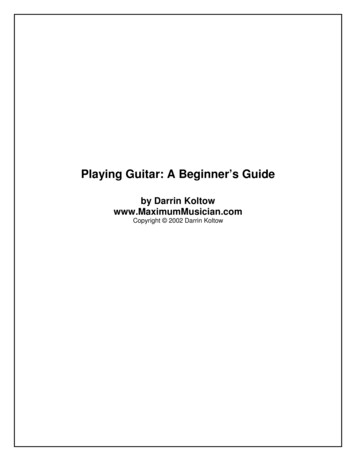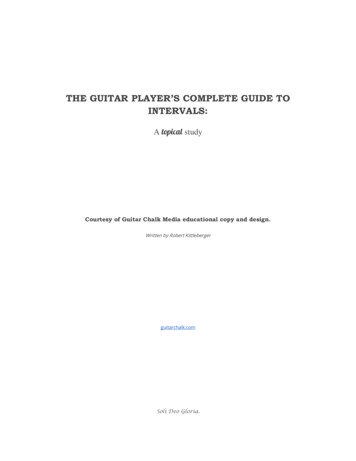
Transcription
THE GUITAR PLAYER’S COMPLETE GUIDE TOINTERVALS:AstudyCourtesy of Guitar Chalk Media educational copy and design.Written by Robert Kittlebergerguitarchalk.comSoli Deo Gloria.
THE GUITAR PLAYER’S GUIDE TO INTERVALS2015If I might be so blunt - guitar is easy.Because in its own unique way, the guitar offers us a lot of versatility in asimple format - the fretboard - which can be navigated in small, incrementalpieces called intervals.So those who understand intervals - even in the most basic sense - will have adistinct command and control of their guitar. They will know what to play, whythey’re playing it and will likely never be at a loss for notes.That’s not to say they’ll never make a mistake or struggle with theirinstrument.But a firm knowledge of intervals can limit those instances, by providing atremendous amount of structure.They’re the building blocks upon which chords, scales and all other notecombinations are built. If we can learn those blocks everything else will make alot more sense.So this is the guide to understanding guitar intervals, in their proper context,and in a manner that's optimal and useful to the guitar player.But rest easy - you need not be a ranking music theorist to understand thismaterial.You just need to want to learn, improve and develop a foundationalunderstanding of what’s happening on the fretboard.If that's the case, intervals are your best starting spot.Good luck.TABLE OF CONTENTS1. What are the parts of an interval?2. Always two notes?3. Go-To Interval Chart4. Simple Example5. What about the major second?pg. 2
THE GUITAR PLAYER’S GUIDE TO INTERVALS20156. Intervals on Different Strings7. What about the perfect fifth?8. What does “consonant” mean?9. A Better Way to Learn10. What is a chord?11. What is a triad?12. Defining the Seventh Chord13. Major Seventh14. Minor Seventh15. Dominant Seventh16. Diminished Seventh17. Half-Diminished Seventh18. The Process19. Getting Started with Dyads20. Getting Started with TriadsMusic was my refuge. I could crawl into the space between the notes andcurl my back to loneliness. Maya AngelouI often mention intervals in my writing and find myself wanting to link to aninformational centerpiece that might explain them.Such a place should be simple.Because intervals are simple. They are useful and wonderfully helpful bits ofknowledge; priceless to the guitar player. But I didn’t have – in my possession such a resource to link to, nor was I able to procure one elsewhere - at leastnot that was straightforward and easy to understand.pg. 3
THE GUITAR PLAYER’S GUIDE TO INTERVALS2015So this article is meant to be that informational centerpiece for one purpose - toteach intervals.That purpose is executed in three parts:1. Explain a theoretical topic.2. Lead to and present methods of application.3. Provide all information in the context of the guitar.If you read through and practice the rest of this content, those three things arewhat you should expect to get in return.Simple, right?If you're still on-board, allow me to be more specific:What I’ll CoverWe’ll look at intervals from three different angles: First: We’ll look at the basic definition of intervals and how to understand themin a formal and theoretical context. This is the “jargon” that you might hear in amusic theory class, though in a more compact and succinct explanation.Second: We’ll look at intervals in chords, using seventh chords as ourapplication and example.Third: We’ll look at intervals in the context of some of the most basic chords inexistence - dyads and triads.Making it through this material means you’ll have a complete and applicableunderstanding of intervals, so that you can use them for chord construction,modal patterns and to provide structure for all melody.Let’s jump in.Defining an Interval: Basic Definition and Music TheorySo what exactly is an interval?We'll look at two basic definitions:In Music Theory: The space between any two pitches or notes (according toHarmony: Its Theory and Practice by Ebenezer Prout).You can download the PDF version of Prout’s book if you’d like to read further.On the Guitar: The space between any two notes or points on the fretboard.pg. 4
THE GUITAR PLAYER’S GUIDE TO INTERVALS2015For example, the following tab is an interval:E -------B -------G -------D -------A -------E --3--5--These two notes are separated by two semitones (which are also called “halfsteps” or one-fret jumps) which are equal to a whole tone or a “whole step.”However, guitar intervals don’t always fall on the same string, as the followingis also an interval:E -------B -------G -------D -------A -----3-E --5-----Instead of falling on the sixth string - like the previous example - the secondnote falls on the fifth string at the third fret.We’ll touch on this more later, but realize that even on different strings there isstill a linear line of frets separating any two notes on the guitar.pg. 5
THE GUITAR PLAYER’S GUIDE TO INTERVALS20151. What are the parts of an interval?A musical interval is made up of two components:1. The Root Note: Represents the key of the particular pattern.2. The Interval(s): Any note(s) that correspond to a particular root are intervals ofthat root.For example, a guitar chord is simply a collection of intervals attached to aspecific root note.Take the following C major chord:E ----B --1-G --0-D --2-A --3-E -----The root C is the root note at the beginning of the interval sequence(highlighted), while the other three notes are all intervals of the root C.Intervals in chords are always understood in relation to the root note or thelowest note in a given key.For instance, the open G in the C chord example is not the interval of the notethat falls on the second or first fret. Rather it’s the interval of the C that falls onthe fifth string at the third fret.Why?Because that C is the root of the entire chord.2. Does an interval always involve onlytwo notes?Yes.Because any one interval can have only one root note and one interval note.Now, there can be more than one set of intervals within a given pattern orchord (depending on how you might break it up), but you can’t have a singlepg. 6
THE GUITAR PLAYER’S GUIDE TO INTERVALS2015interval with more than two parts. It’s always just one note added to a rootnote.It’ll make more sense once we look at some examples.3. The Go-To ChartThere are a total of 11 different intervals before you get to your first octave,which doubles the frequency of the original note.Therefore each interval should have a “Number of Frets” and an “IntervalQuality.”You’ll identify intervals by associating the number of frets with thecorresponding interval quality and vice-versa. Here’s a chart that displays thatinformation for all 12 intervals:The only thing we've omitted is an interval with 0 semitones, or essentially thesame note played twice at the same time. This is simply called a unisoninterval, though it is not often mentioned or regarded as a common interval.So how do we read this and translate it to the fretboard?Let’s start with something easy.pg. 7
THE GUITAR PLAYER’S GUIDE TO INTERVALS20154. A Simple ExampleSay you were in music class and the teacher wanted you to draw a minorsecond on the chalkboard in guitar tab form.What would you do?First, you know from the above chart that a minor second is one semitone orone fret from the root. That means you’ll have a root note plus a note that fallsone semitone from that particular spot.So you’ve got plenty of options.Here’s one:E -------B -------G -------D -------A -------E --3--4--In this example, the root note is at the third fret (G) and the interval falls at thefourth fret, creating one semitone of separation and giving us a minor secondinterval.5. What about a major second?To create a major second, we simply go back to our interval chart and figureout how many semitones we need to have separating our interval from our rootnote.In this case, it’s just two.You’re probably ahead of me by now.Here’s our major second:E -------B -------G -------D -------A -------E --3--5--Make sense?pg. 8
THE GUITAR PLAYER’S GUIDE TO INTERVALS2015You can continue through the chart in the same fashion.6. Intervals on Different StringsSo how do we get situations where intervals land on other strings?It’s harder to visualize, but what’s happening is the exact same process. Let’suse the major third interval as our example, since it’s one of the easiest toillustrate.I’ll show you how to draw one up on a tab sheet with the two notes on separatestrings.What do we do first?We can look to our chart (or memorize it - either way is fine) and see that thereare four semitones that separate our major third interval from the root note.So right away we could come up with this tab:E -------B -------G -------D -------A -------E --3--7--This is a major third interval.But there’s a problem. It’s a really long jump from the root note to the seventhfret, thus an inefficient movement.And there’s a better way to play it.If we know our fretboard notes, we can see that the note at the seventh fret is aB. To get a more optimal interval, all we have to do is find the same B on thefifth string.E -------B -------G -------D -------A -----2-E --3-----That B falls on the fifth string - at the second fret - much closer to the root Gat the third fret.pg. 9
THE GUITAR PLAYER’S GUIDE TO INTERVALS20157. Compound IntervalsKnow that you can identify any B note on any other string as a major thirdinterval of the root G.For example, the following highlighted note is also a B:E -------B -------G -----4-D -------A -------E --3-----Technically it’s an octave higher, which makes it a compound interval, butyou can still refer to it as a major third, with or without regard to the octavedifference.A compound interval is any interval that occurs after the intervals that fallbetween the root note and the first octave (simple intervals).That's a bit of a side note, but still worth banking in your memory.Let's move on.8. What about the Perfect Fifth?You might have heard the term “perfect fifth” before and noticed it on theinterval chart.This is an important interval to learn, as it forms one of the most basic powerchord shapes in existence.You’re almost certain to recognize it.Arpeggio FormE -------B -------G -------D -------A -----5-E --3-----Chord Formpg. 10
THE GUITAR PLAYER’S GUIDE TO INTERVALS2015E ----B ----G ----D ----A --5-E --3--In this case we have our root G and the interval note D falling seven semitonesabove the root.That seven semitone spread is what gives us our perfect fifth, making it anextremely common shape. And why is it called “perfect?” Music theorists havelong used the term “perfect” to denote two intervals that sounded, and wereconsidered to be, perfectly consonant.For this reason a perfect fifth can also be referred to as the “consonantinterval” or “highly consonant.”9. What exactly does consonant mean?In music, consonant always describes two notes that agree or soundcomplimentary when played together or close to one another.It’s derived from the audible dichotomy between consonance and dissonance.These terms are difficult to properly define, though can be generally thought ofas opposites, where consonance is considered stable and dissonance isconsidered unstable. It is essentially based on the perception of unity orcohesiveness between two notes.You can have both perfect consonances and imperfect consonances:Perfect1. Unisons and Octaves2. Perfect Fourths and Perfect FifthsImperfect1. Major Thirds and Minor Sixths2. Minor Thirds and Major SixthsNote that you can memorize, understand and use the perfect fifth without fullycomprehending the idea of a consonant interval.pg. 11
THE GUITAR PLAYER’S GUIDE TO INTERVALS2015I suppose you could think of that topic as extra credit, and not crucial for realworld application.Transitioning to ApplicationWe’ve been looking at intervals in terms of their theoretical definition.So now you should know what intervals are and how to explain them usingformal, conceptual language.You’re ready to take this knowledge and apply it to the fretboard. Our approachwill be a two-lane road:1. We’ll continue to look at music theory as it pertains to basic guitar chords.2. Second, we’ll apply what we already know about intervals to things we do onthe fretboard.Once you’ve done this you’ll understand intervals not just in theory, but in apractical sense, having seen how they can actually help you.We’ll look at understanding intervals in the context of seventh chords, dyadsand triads.Understanding Intervals by Studying Seventh ChordsHave you ever wondered what a seventh guitar chord actually is?What does that number mean?Or what about the theory behind seventh chords? How does it all work?These are questions you’ve probably asked yourself before simply memorizingthe chord and moving on. Still, you continue to think, “Isn’t there a better wayto learn this outside of note-by-note memorization?”And the answer is yes - there is a better way to learn.In fact going a little deeper with this topic, will show us a lot about intervalsand music theory in general.A Better Way to LearnBecause of the way my brain is wired, I’m intensely pragmatic and skeptical.pg. 12
THE GUITAR PLAYER’S GUIDE TO INTERVALS2015As a result, I tend to look for ways to understand music at a deeper level and“connect the dots,” so to speak. That’s what we’ll do here with seventh chords.Instead of just memorizing them and learning the fingerings, we’re going tolearn how to build them from the ground up.In so doing we’ll learn about the purpose and function of intervals.Background InformationTo understand seventh chords you have to first understand the basicunderpinnings of what a chord is and what a triad is.We’ll consider both of the following: Formal Definition of a ChordFormal Definition of a TriadOnce we’ve covered those two concepts, we can responsibly define and studyseventh chords.10. What is a chord?Conventionally a chord is a combination of three or more notes, heard eithersimultaneously or in succession like an arpeggio.Webster’s Dictionary defines it like this:Three or more musical tones soundedsimultaneously.In contrast, Ottó Károlyi, a senior music professor at the University of Stirling,recognizes two or more notes as a musical chord.Two or more notes sounding simultaneouslyare known as a chord. Károlyi, Otto (1965)pg. 13
THE GUITAR PLAYER’S GUIDE TO INTERVALS2015I tend to favor Károlyi’s definition and hold that two notes or more should beconsidered a chord. However, both are valid explanations.11. What is a Triad?Formally, a triad is a chord made up of three notes which are successive thirdintervals.But what does that mean?Well, we’ve got three notes to work with. And we know that one of them, thelowest one, will be the root note, while the others will be correspondingintervals.The next note will be a third (either major or minor) from the root note, whilethe last note will be a fifth (diminished, perfect or augmented).So a triad includes: A root note.Third interval (major or minor) from the root note.Fifth interval (diminished, perfect or augmented) from the root note.Take the following major triad example:pg. 14
THE GUITAR PLAYER’S GUIDE TO INTERVALS2015You’ve got your root, which is easily identified as your lowest note. Then yourmajor third which is four semitones away from the root. So if you were to startat the root note and count up the fretboard four frets, that note would matchthe one at the third fret on the second string.We saw this earlier in our major third example from the first chapter.Same goes for the perfect fifth, which is seven frets (semitones) from the rootnote.Visualize the process by simply counting up from the root note on the samestring.pg. 15
THE GUITAR PLAYER’S GUIDE TO INTERVALS2015You can see that the note occurring four frets up from our root note (on thefourth fret) is a C, which means we can use the C on the fifth string at the thirdfret to begin the construction of our triad.This is our formal definition of a triad.But there’s a more casual way to explain it as well, with some lingeringauthority.The Casual Definition of a Triad20th Century theorists, Howard Hanson and Carlton Gamer, expanded theterm to make room for essentially any group of three notes, or pitches, that arecombined for a chord.This gives us both a formal and casual definition.Here’s a graphic to help memorize each one:pg. 16
THE GUITAR PLAYER’S GUIDE TO INTERVALS2015Though it’s true that Hanson and Gamer’s definition is valid and easier todigest, we need to be aware of the formal definition of a triad in order tounderstand the interval structure of seventh chords.Up to this point, we’ve prioritized a baseline understanding of chords andtriads in a general sense, having yet to look at any actual seventh chords.But now, the foundational information has been covered and we can finally getto a seventh chord definition.12. Defining Seventh ChordsUnlike our previous two definitions, there’s little room for interpretation whenit comes to determining what a seventh chord actually is.Note that the formal definition is exclusive.A seventh chord consists of a triad plus one morenote that forms a seventh interval with thattriad’s root note.If you understand intervals and triads, it’ll be easier for you to construct aseventh chord as well, because we're simply adding one more note to anestablished triad.pg. 17
THE GUITAR PLAYER’S GUIDE TO INTERVALS2015It becomes a matter of simply counting intervals.Take the following seventh chord for example:You’ve got a root note, major third, perfect fifth and a major seventh that cometogether to form a basic major seventh chord.And we can get there entirely by counting intervals from the root note.Now up to this point we’ve only used major triads for our examples.There are five other common or “Tertian” seventh chords that we’ll cover tomake sure we know the process and the way they’re constructed.1.2.3.4.5.Major SeventhMinor SeventhDominant SeventhDiminished SeventhHalf-Diminished SeventhThe process is the same for each type of chord – simply build each chordstarting with a root note, then add a third, fifth and seventh interval.I’ll give you the interval pattern for each chord, since all of them have differentinterval sequences. If you prefer, those sequences can be viewed via theseventh chord wiki page.pg. 18
THE GUITAR PLAYER’S GUIDE TO INTERVALS201513. Major Seventh ExampleWe'll go ahead and build out our major seventh chord on guitar tabs.Remember, all we need to start is one triad.Start with this major triad shape.E ----------B --------3-G -----4----D --5-------A ----------E -----------By now it should be fairly easy for you to spot the root note, third interval andfifth interval in our triad. Remember, it’s still a major chord, so the intervals forour major seventh chord will have the following qualities:pg. 19
THE GUITAR PLAYER’S GUIDE TO INTERVALS2015Major Third - Perfect Fifth - Major SeventhIf you memorize this, you can create a major seventh chord with any root noteof your choice.So all you’ve got to do now is add the major seventh interval.Where do you think it would go? How could we figure it out?Remember that a major seventh interval is 11 semitones from the root note. Sowe can simply count from the root note on the fourth string at the fifth fret, allthe way up the fretboard.If you do that you’ll go from the fifth fret to the 16th fret.E --------------------B --------------------G --------------------D ----5-----------16--A --[root]-------[F#]-E ---------------------That means we’re looking for an F# near our original chord. The first note thatcomes to mind might be the low F# on the sixth string, but that’s not afunctional option.However, the F# on the high E string is in perfect position to complete ourmajor seventh chord.E --2-B --3-G --4-D --5-A ----E -----You can apply the same process to any other triad to make it a major seventhchord.Notice how knowledge of intervals becomes increasingly crucial.14. Minor SeventhAll of the same principles will apply to the minor seventh chord, where the onlydifference is that third and seventh intervals will be minor in their relation tothe root note.pg. 20
THE GUITAR PLAYER’S GUIDE TO INTERVALS2015Here are the intervals we need to use.Minor Third - Perfect Fifth - Minor SeventhWe now have our root note on the sixth string at the fifth fret, meaning ourchord is going to be an Amin7 by the time we’re finished.Our first interval is a minor third which is three semitones from the root.The perfect fifth interval is the same as before, now falling on the second stringat the seventh fret.E ----B ----G --5-D --X-A --7-E --5--In order to add our minor seventh interval, we need to count ten frets up fromthe root note.This gives us a G, which we can include in our chord with the G note at theeighth fret on the second string.E ----B --8-G --5-D --X-A --7-E --5--15. Dominant SeventhA dominant seventh chord will be composed of a root, plus the followingintervals:Major Third - Perfect Fifth - Minor SeventhLet’s start with an E at the seventh fret on the fifth string.E ----B ----G ----D ----A --7-E -----pg. 21
THE GUITAR PLAYER’S GUIDE TO INTERVALS2015Our major third and perfect fifth should be easy by now, leading us to thefollowing shape:E --7-B --x-G --x-D --6-A --7-E -----Now we need to add our minor seventh, which will be a D note, considering ourroot E.E --7-B --x-G --7-D --6-A --7-E -----The seven, highlighted in red, is our D note, completing the dominant seventhchord.16. Diminished SeventhFiguring out the diminished seventh will be slightly trickier because you’ll havetwo diminished intervals to deal with.Minor Third - Diminished Fifth - Diminished SeventhOur diminished fifth (also know as a Tritone), is going to be six semitones fromthe root note or one less than what we were becoming accustomed to with theperfect fifth.The sound it creates is dissonant, which you may recall we mentioned earlier issimply the opposite of consonant.E --x-B --x-G --6-D --4-A --3-E --5--In order to add our diminished seventh note, we’ll need to go nine semitonesabove the root note, which in this case is A. 10 semitones would get us to G, soone less will be F#, which we’ve highlighted red in our chord.pg. 22
THE GUITAR PLAYER’S GUIDE TO INTERVALS201517. Half-Diminished SeventhThe half diminished seventh requires the following three intervals from theroot:Minor Third - Diminished Fifth - Minor SeventhSo this chord will actually be a bit easier to understand than the diminishedseventh, since we have two minor intervals instead of two diminished intervals.We’ll start with our root note here:E ----B ----G ----D ----A ----E --3--Remember that a diminished fifth is six semitones above the root.E ----B ----G --6-D --x-A --x-E --3--Now we can add our minor third and seventh intervals.E ----B ----G --6-D --3-A --1-E --3--The same principles can be applied to the minor major seventh chord and theaugmented major seventh chord, which are not listed here, but are stillconsidered Tertian. As long as you know the intervals, you’re good to go.Want to see them all in one place?Here you go:Major Seventh: Major Third - Perfect Fifth - Major SeventhMinor Seventh: Minor Third - Perfect Fifth - Minor Seventhpg. 23
THE GUITAR PLAYER’S GUIDE TO INTERVALS2015Dominant: Major Third - Perfect Fifth - Minor SeventhDiminished: Minor Third - Diminished Fifth - Diminished SeventhHalf-diminished: Minor Third - Diminished Fifth - Minor SeventhMinor Major Seventh: Minor Third - Perfect Fifth - Major SeventhAugmented Major: Major Fifth - Augmented Fifth - Major SeventhIf you know the intervals you can discern and even build your own chordspretty quickly. So instead of looking up a bunch of seventh guitar chords andsimply memorizing, you can make them from scratch.Pretty cool, right?Instead of having a surface knowledge and not really know what you’re playing,you know why every single note in these chords exists, namely because youknow the four components that make up a seventh chord and the properties ofeach interval.Let’s go ahead and review: RootThird IntervalFifth IntervalSeventh IntervalIt’s not easy, at least not for the average music student.But most things worth learning, like music theory, aren’t easy.If you commit to learning the process and giving it time, all this stuff willbecome second nature.18. The ProcessThat process is critically important because it's repeatable.Instead of memorizing the actual chords, we've memorized the mechanism bywhich we get to any chord.So for easy memorization of the process:1. Understand the basic definition of a chord.pg. 24
THE GUITAR PLAYER’S GUIDE TO INTERVALS20152. Understand the definition and formal components of a triad (root, thirdand fifth interval).3. Learn how to count intervals from the root notes (by the number ofsemitones - use the chart provided).4. Build your seventh chords by finding a root note and adding theappropriate intervals depending on the commons name (major, minor,diminished, etc.) of the chord you want.Easier said than done, but it’s all there.And once you learn it, you’ll be ahead of most who just rely on raw chordmemorization - with no interest in music theory - to get by.Simple Guitar Chords: Dyad and Triad TheoryI mentioned that we would be using dyads and triads to illustrate our chordsand apply our intervals.Dyads and triad (which we've already covered in part) are the next step aboveintervals in terms of fretboard building blocks. They're the simplest and mostbasic guitar chords you can learn.We define the two types of chords this way: Dyad: A chord made up of only two notes - a root note and one interval.Triad: A chord made up of three notes - a root note and two intervals.Though the theory gets more involved, we can start with this basicunderstanding of our two chord types and go from there.We've already covered triads, so let's focus on dyads.We'll say that a dyad is any interval that can be interpreted as reasonablyconsonant.Fair enough?Let's look at some examples.19. Basic Dyads to Start WithWe want to start simple, so we’ll look at two different types of dyads, which aredistinguished by the interval of each chord. Major Fifth Dyadpg. 25
THE GUITAR PLAYER’S GUIDE TO INTERVALS 2015Octave DyadSo the distance between the root note and the second note in the chord willdetermine what type of dyad it is just like in any interval that we might use.Major Fifth or "Perfect" DyadA major fifth is the term used to designate one such interval, which is sevenfrets away from the root note. Here’s the tab.E ----B ----G --7-D --5-A ----E -----I’ve chosen to put my root note on the fourth string at the fifth fret, but you canstart this root note on any fret on either the sixth, fifth, fourth or second stringand play the same configuration.The note at the seventh fret is a perfect fifth and the only note thataccompanies the root.This is your first, basic dyad.Octave DyadAn octave dyad looks almost the same, except our interval is one octave higherthan the root note, which means it’s the same note at a higher pitch.Here’s the tabbed example.E ----B ----G --7-D --x-A --5-E -----D Major Dyad ShapeThe major sound you get from the basic shape of a D chord is also a moveabledyad.E ----B --3-G --2-D ----pg. 26
THE GUITAR PLAYER’S GUIDE TO INTERVALS2015A ----E -----We omit the root D and instead allow the A at the second fret to function as ourroot (or we assume the root D as a ghost note). If we move the note at the thirdfret (D) up to the fifth (E), we have another useable dyad.Again, a perfect fifth:E ----B --5-G --2-D ----A ----E -----20. Triadic ChordsThere are a lot of different ways to configure a triadic chord, though most aresimply an expansion on commonly used dyads. For example, if you take the Dmajor dyad shape we just covered and add the root note, you get a fairlycommon triadic chord with a D root.E ----B --3-G --2-D --0-A ----E -----To transpose the chord to a new fret, simply move the root note to the desiredkey.E ----B --6-G --5-D --3-A ----E -----Commonly Used Major and Minor Triadic ChordsThere are a lot of different chords that are made up of three notes. We’ll givemost of these chords in the key of C, though keep in mind they can be movedto any fret.Like dyads, each chord form is signified by a collection of intervals and octaves.pg. 27
THE GUITAR PLAYER’S GUIDE TO INTERVALS2015In many cases, a triadic chord can be a stripped down version of a morecommonly known open chord. Take the open C major for example.E ----B --1-G --0-D --2-A --3-E -----We have four notes here, but we can omit the highest one on the first fret (C)since we’re already getting a C from the root note on the third fret.Now our triadic shape looks like this, and we can more easily move it to otherfrets:E ----B ----G --0-D --2-A --3-E -----Thus, if we transpose the root of the chord to the fifth fret, we’d get thefollowing shape:E ----B ----G --2-D --4-A --5-E -----Try picking through each shape one after another.E -------------------B -------------------G --------0--------2-D -----2--------4----A --3--------5-------E --------------------Let’s look at a few more triadic shapes.The Power Chord Triadic ShapeOne of the most frequently used chords would be a power chord made up ofthree notes.pg. 28
THE GUITAR PLAYER’S GUIDE TO INTERVALS2015The first is the root note, followed by a perfect fifth interval and then an octaveof the original root note.E -----B -----G -----D --10-A --10-E --8---This chord can be easily moved and can work with a root note on either thesixth or fifth string.You can change the interval of the chord (the note in the middle) if you want togive the chord a different tone. Instead of adding a perfect fifth, add a majorthird, which will fall on the seventh fret.E -----B -----G -----D --10-A --7--E --8---The Major Barre Chord Tria
THE GUITAR PLAYER’S GUIDE TO INTERVALS 2015 pg. 4 So this article is meant to be that informational centerpiece for one purpose - to teach intervals. That purpose is executed in three parts: 1. Explain a theoretical topic. 2. Lead to and present methods of application. 3. Provide all i

